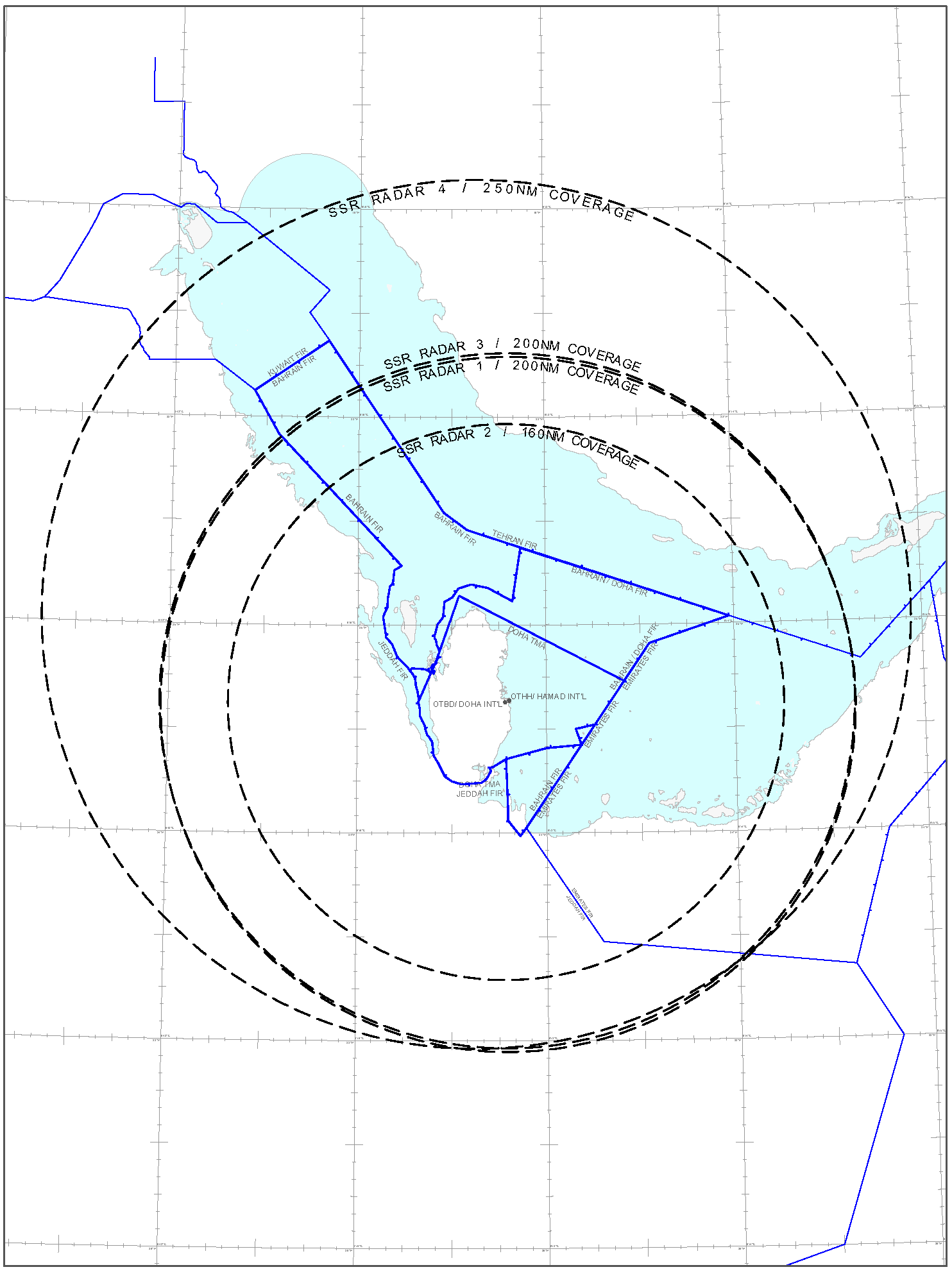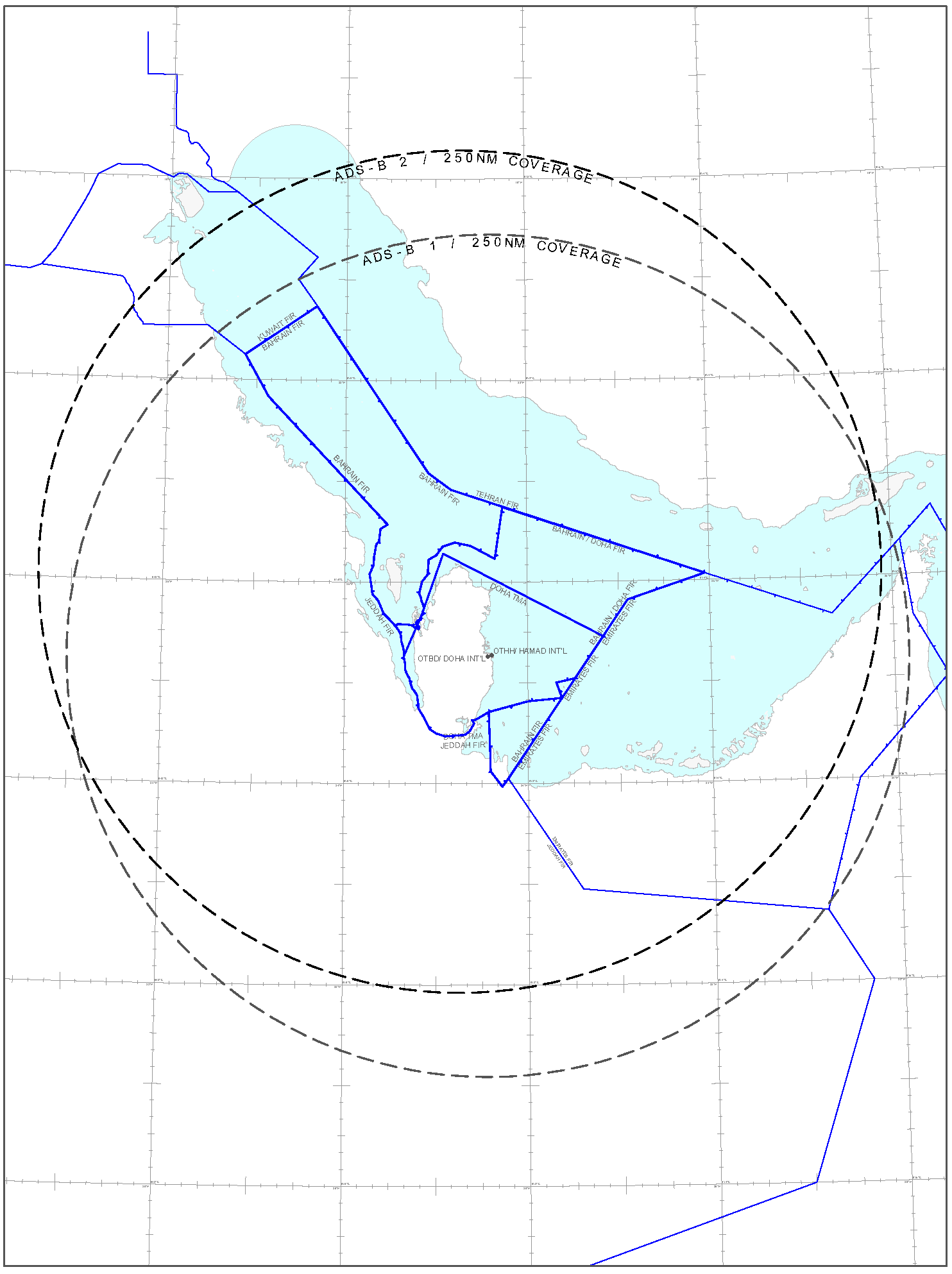ENR 1.6 ATC SURVEILLANCE SERVICES AND PROCEDURES
1 Primary surveillance radar (PSR)
- PRIMARY RADAR 1 (ASR/PSR): DOHA APP – 251419.90N 0513552.20E
- PRIMARY RADAR 2 (ASR/PSR): DOHA APP – 251624.61N 0513513.56E
- PRIMARY RADAR 3 (ASR/PSR): DOHA APP/ACC (En-route Radar) - 260621.10N 0511542.80E
2 Secondary surveillance radar (SSR)
- SECONDARY RADAR 1 (ASR/SSR): DOHA APP - 251419.90N 0513552.20E
- SECONDARY RADAR 2 (ASR/SSR): DOHA APP – 251541.70N 0513428.60E
- SECONDARY RADAR 3 (ASR/SSR): DOHA APP - 251624.61N 0513513.56E
- SECONDARY RADAR 4 (ASR/SSR): DOHA APP/ACC (En-route Radar) - 260621.10N 0511542.80E
- SECONDARY RADAR 1 RANGE: 200 NM centered on position 251419.90N 0513552.20E
- SECONDARY RADAR 2 RANGE: 160 NM centered on position 251541.70N 0513428.60E
- SECONDARY RADAR 3 RANGE: 200 NM centered on position 251624.61N 0513513.56E
- SECONDARY RADAR 4 RANGE (En-route Radar): 250 NM centered on position 260621.10N 0511542.80E
3 Automatic dependent surveillance - Broadcast (ADS-B)
4 SUPPLEMENTARY SERVICES
4.1 General
4.2 The application of radar control service
- Radar separation of arriving, departing and en-route traffic;
- Radar monitoring of arriving, departing and en-route traffic to provide information on any significant deviation from normal flight path;
- Radar vectoring when required;
- Assistance to aircraft in emergency;
- Assistance to aircraft crossing controlled airspace;
- Warnings and position information on other aircraft considered to constitute a hazard;
- Information to assist in the navigation of aircraft;
- Information on observed weather.
- From the centre point of the radar coverage up to 40 NM - 3 NM radar separation.
- Beyond 40 NM - 5 NM radar separation.
- ‘SUPER HEAVY’ - all aircraft types of 100,000 KG or more, and a wingspan between 72 M and 80 M;
- ‘UPPER HEAVY’ - all aircraft types of 100,000 KG or more, and a wingspan between 60 M and 72 M;
- ‘LOWER HEAVY’ - all aircraft types of 100,000 KG or more, and a wingspan below 52 M;
- ‘UPPER MEDIUM’ - aircraft types less than 100,000 KG but more than 15,000 KG, and a wingspan above 32 M;
- ‘LOWER MEDIUM’ - aircraft types less than 100,000 KG but more than 15,000 KG, and a wingspan below 32 M;
- ‘LIGHT’ - all aircraft types of 15,000 KG or less (without wingspan criterion).
| Alternate (RECAT) Application of Wake Turbulence Separation | Follower | |||||||
|---|---|---|---|---|---|---|---|---|
| Super Heavy | Upper Heavy | Lower Heavy | Upper Medium | Lower Medium | Light | |||
| CAT-A | CAT-B | CAT-C | CAT-D | CAT-E | CAT-F | |||
| (*) The separation minimum to be applied is the horizontal separation minimum based on an ATS surveillance system and should remain compatible with runway capacity. | ||||||||
| Leader | Super Heavy | CAT-A | 3 NM | 4 NM | 5 NM | 5 NM | 6 NM | 8 NM |
| Upper Heavy | CAT-B | (*) | 3 NM | 4 NM | 4 NM | 5 NM | 7 NM | |
| Lower Heavy | CAT-C | (*) | (*) | 3 NM | 3 NM | 4 NM | 6 NM | |
| Upper Medium | CAT-D | (*) | (*) | (*) | (*) | (*) | 5 NM | |
| Lower Medium | CAT-E | (*) | (*) | (*) | (*) | (*) | 4 NM | |
| Light | CAT-F | (*) | (*) | (*) | (*) | (*) | 3 NM | |
| Alternate (RECAT) Application of Wake Turbulence Separation | Follower | |||||||
|---|---|---|---|---|---|---|---|---|
| Super Heavy | Upper Heavy | Lower Heavy | Upper Medium | Lower Medium | Light | |||
| CAT-A | CAT-B | CAT-C | CAT-D | CAT-E | CAT-F | |||
| Leader | Super Heavy | CAT-A | 100s | 120s | 140s | 160s | 180s | |
| Upper Heavy | CAT-B | 100s | 120s | 140s | ||||
| Lower Heavy | CAT-C | 80s | 100s | 120s | ||||
| Upper Medium | CAT-D | 120s | ||||||
| Lower Medium | CAT-E | 100s | ||||||
| Light | CAT-F | 80s | ||||||
- an intermediate part of the same runway; or
- an intermediate part of a parallel runway separated by less than 760 M (2,500 FT).
- in the final approach and landing phase of flight and is:
- 5000 FT AMSL or below; and
- 7 NM or less behind an aircraft of the same or higher wake turbulence category.
or;
- in the take-off and climb out phases of the flight and:
- has departed behind an aircraft of a higher wake turbulence category within a period of 200s or less from the previous departure; and
- is below 5000 FT AMSL.
| Severity | Description | Pitch Upset or Altitude Lost | Roll (Bank Angle) reported as angle deviation from ground |
|---|---|---|---|
| Light | Wake turbulence that momentarily causes slight erratic changes in altitude or attitude (Pitch, yaw, or - most usually - Roll). May include rhythmic attitude changes. | Less than 50 FT/minor | Less than 10° |
| Moderate | Wake turbulence that is similar to light wake turbulence, but of a greater intensity. Larger changes in altitude and/or attitude occur, but the aircraft always remains in positive control. | Less than 100 FT | Between 10-30° |
| Severe | Wake turbulence that causes large, abrupt changes in altitude and/or attitude (most typically large, uncommented roll rates and resulting bank angles, often followed by a reverse direction roll). Aircraft may be momentarily out of control. | More than 100 FT | Greater than 30° |
4.3 Emergency procedures
Note: Continuous monitoring of responses on Mode A / 3 Code 7700 is provided.
4.4 Radar and Radio communication failure procedures
4.4.1 Radar failure
In the event of radar failure or loss of radar identification, instructions will be issued to restore non-radar standard separation and the pilot will be instructed to communicate with the parent ATS unit.
4.4.2 Air-ground communication failure
4.4.3 Radio communication failure procedure
In the event of an apparent radio communication failure, the pilot of an aircraft should:
- Maintain Terrain Clearance at all times;
- Squawk 7600;
- Contact appropriate alternate and secondary published ATS frequencies;
- Check aircraft communications equipment;
- Listen to ATIS;
- Broadcast intentions (assuming aircraft transmitter is functioning) and prefix transmission with "TRANSMITTING BLIND"
If a pilot of an aircraft is flying in VMC and is certain that VMC can be maintained, the pilot should:
- Continue to fly in VMC;
- Land at the nearest suitable aerodrome;
- Report arrival by the most expeditious means to the appropriate ATC unit.
If the pilot of an aircraft is flying in IMC or is uncertain that a VMC can be maintained, the pilot should:
- Maintain the last assigned speed and level, or minimum flight altitude if higher, for a period of three (3) minutes following:
- the last assigned level or minimum flight altitude is reached; or
- the last time the transponder is set to Code 7600;
whichever is later, and thereafter adjust level and speed in accordance with the filed flight plan; or
- If being vectored, proceed in the most direct manner possible to rejoin the current flight plan route no later than the next significant point, taking into consideration the applicable minimum flight altitude;
- When on arrival, follow (1) and (2) as applicable, then:
- proceed according to the current flight planned route to appropriate designated navigation aid or fix, if necessary, to ensure compliance with (b) below;
- if cleared on a STAR, commence descent from the holding fix associated with the STAR as close as possible to the Expected Approach Time (EAT) last received and acknowledged. If no EAT has been received, commence descent from the holding fix associated with the STAR as close as possible to the Expected Time of Arrival (ETA) resulting from the flight plan. Follow the Radio Communication Procedure shown on the relevant STAR chart;
- in the event a STAR clearance has not been issued, select code 7600 and follow the STAR most appropriate to the inbound route and last known landing runway.
4.5 Unlawful interference procedures
Pilots of the aircraft in flight subjected to unlawful interference shall endeavour to set the transponder to Mode A Code 7500 to give indication of the situation, unless circumstances warrant the use of A / 3 Code 7700.
Note: Continuous monitoring of responses on Mode A / 3 Code 7500 is provided.
4.6 Graphic portrayal of Secondary Radar coverage areas
 |
4.7 Graphic portrayal of ADS-B coverage areas
 |
|---|